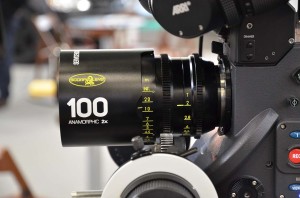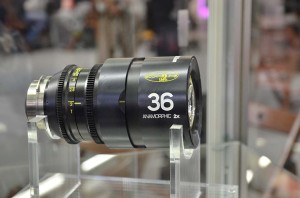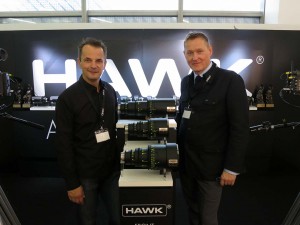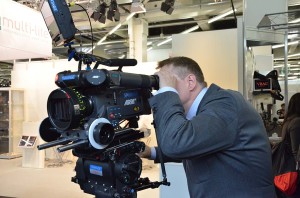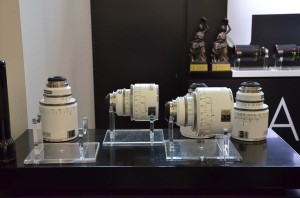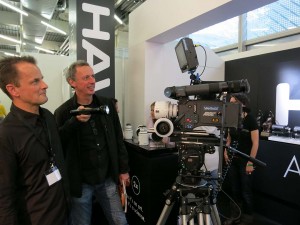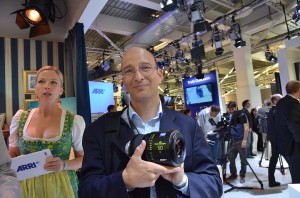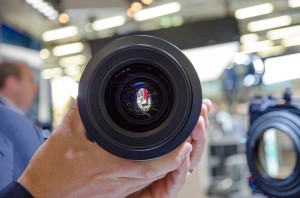It was an Anamorphic Cinec. The big news for many were the many new lenses announced to squeeze a 2.39:1 scene onto a 4:3 sensor. As predicted, the race to provide and produce classic ‘Scope 2x squeeze lenses is on. Panavision and Vantage still have the largest inventories so far. Vantage is building new lenses and introducing new designs at a prodigious rate, while Scorpio and ZEISS announced new sets.
Servicevision showed a working 100mm 2x anamorphic prime (above) and a 36 mm model. Six lenses are planned to be shown at NAB 2013: 36, 40, 50, 64, 80 and 100 mm, with delivery toward end of 2013. They have 95 mm front diameters. The lenses are small, light, with no distinguishable breathing. The 100 mm T2.0 working prototype had smooth cam focus, and focused incredibly close without any “mumps” bloating effect. The anamorphic image, seen through the optical finder of an Alexa Studio, was pleasing, with a painterly look. The bokehs are not classic ovals, but they have a distinctively different look.
Hawk showed 3 new front anamorphic zooms, 5 new Vintage ’74 Hawk anamorphics and a new 20mm wide angle anamorphic lens.
Because they have front anamorphic cylinders, the 30-60, 45-90 and 80-180 mm T2.8 zooms match all the other Hawk primes. (Many existing anamorphic zooms are conversions. They take an existing zoom lens and add a “squeeze” adapter to the rear. The look is different.
The Vintage ’74 Hawks, with their distinctive white barrels, use coatings derived from the 1970s. These coatings create more internal barrel flare, hazing, lower contrast, milkier shadows, more flare, bluer streaks — all the things lens manufacturers have been designing out for the past 3 decades and that suddenly has become all the rage. Why? As Danys Bruyere said at the semi-annual Cooke dinner, “There are more than 3,000 Alexas out there, and they all have the same sensor and the same look. It’s the lens that makes the difference, and that’s why there’s so much interest in vintage and anamorphic optics lately.”
Flashlights were peering down barrels everywhere at Cinec–in search of narcissism (secondary images or flares), blue streaks, bokehs and interesting aberrations. The debate heated up: are oval bokehs necessary to anyone other than several dozen compulsive cinematographers and optical designers? Can you tell the difference between a native blue streak and one added with a blue streak filter? Your answer will partially determine your selection of lenses. The other things influencing your choice will be size, weight, ergonomics, price, serviceability, and above all, overall look.
ARRI showed the new ARRI/ZEISS 50 mm T2.0 anamorphic on an Alexa Studio, with a 35 mm model on a pedestal nearby. The anamorphic cylinders are distributed throughout the lens, but you can see the “classic” oval shape when you peer through the front.
This anamorphic feeding frenzy was good news for the occupants at 89 Tuerkenstrasse. Currently ARRI is one of the few manufacturers providing digital motion picture cameras with 4:3 sensors that accommodate the 2x anamorphic format. Alexas, of course, come with a PL mount, but swapping to an aftermarket PV (Panavision) mount is quick and easy, and Panavision sub-rentals account for some of the largest inventories of Alexas.
The occupants of Altstrasse 9 in Weiden were also smiling: Hawk has many of their 2x anamorphics also available in 1.3x squeeze. (A 2x anamorphic lens on a 16:9 sensor camera will have a crop factor: it looks more enlarged).
Danys Bruyere had the final word at the Cooke dinner. He gave a long and impassioned plea to Cooke to come up with Cooke Anamorphic lenses. The heat is on.

